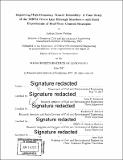Improving high-frequency transit reliability : a case study of the MBTA Green Line through simulation and field experiments of real-time control strategies
Author(s)
Fabian, Joshua Javier
DownloadFull printable version (18.50Mb)
Alternative title
MBTA Green Line through simulation and field experiments of real-time control strategies
Other Contributors
Massachusetts Institute of Technology. Department of Civil and Environmental Engineering.
Advisor
John P. Attanucci, Frederick P. Salvucci and Gabriel E. Sánchez-Martínez.
Terms of use
Metadata
Show full item recordAbstract
Service reliability is a major concern for public transportation agencies. Transit services experience natural variability in scheduled service, due to factors such as traffic congestion, irregular demand, multi-route and branching corridors, and operator behavior. This variability leads to irregular headways, resulting in longer passenger waits and decreased effective capacity as gaps in service form. Real-time control strategies allow controllers to intervene at terminals and en route to regulate headways and improve performance. This research tests the effectiveness of holding control strategies on the Massachusetts Bay Transportation Authority (MBTA) Green Line in Boston, a complex, four-branch light rail line. A simulation model is developed to estimate and compare the benefits of different schedule-based and headway-based holding strategies. Dispatching trains at terminals to target headways is found to minimize wait time, and the addition of en route holding improves service further, albeit slightly. The simulation results inform the design of a field experiment, in which headway-based dispatching is implemented at a Green Line branch terminal. Terminal personnel are provided with tablet computers showing departure times optimized by an even-headway policy. When optimized departure times are adhered to, peak-hour headway variability is reduced by 40%. The average wait is shortened by 15% (30 seconds), and the 90th percentile wait is shortened by 21% (90 seconds). Compliance with the recommended departure times in the experiment was hampered by various human factors and station features. During the experiment, only 49% of trips left within 45 seconds of the departure times recommended by the algorithm. These results show that adopting headway-based dispatching at terminals promises significant benefits to service and passengers if operational changes are accompanied by improved supervision practices. This research fully supports the idea that transit agencies, such as the MBTA, should allocate supervisory resources for high-frequency services to prioritize terminal headway control versus en route and schedule-based strategies.
Description
Thesis: S.M. in Transportation, Massachusetts Institute of Technology, Department of Civil and Environmental Engineering, 2017. Cataloged from PDF version of thesis. Includes bibliographical references (pages 175-179).
Date issued
2017Department
Massachusetts Institute of Technology. Department of Civil and Environmental EngineeringPublisher
Massachusetts Institute of Technology
Keywords
Civil and Environmental Engineering.